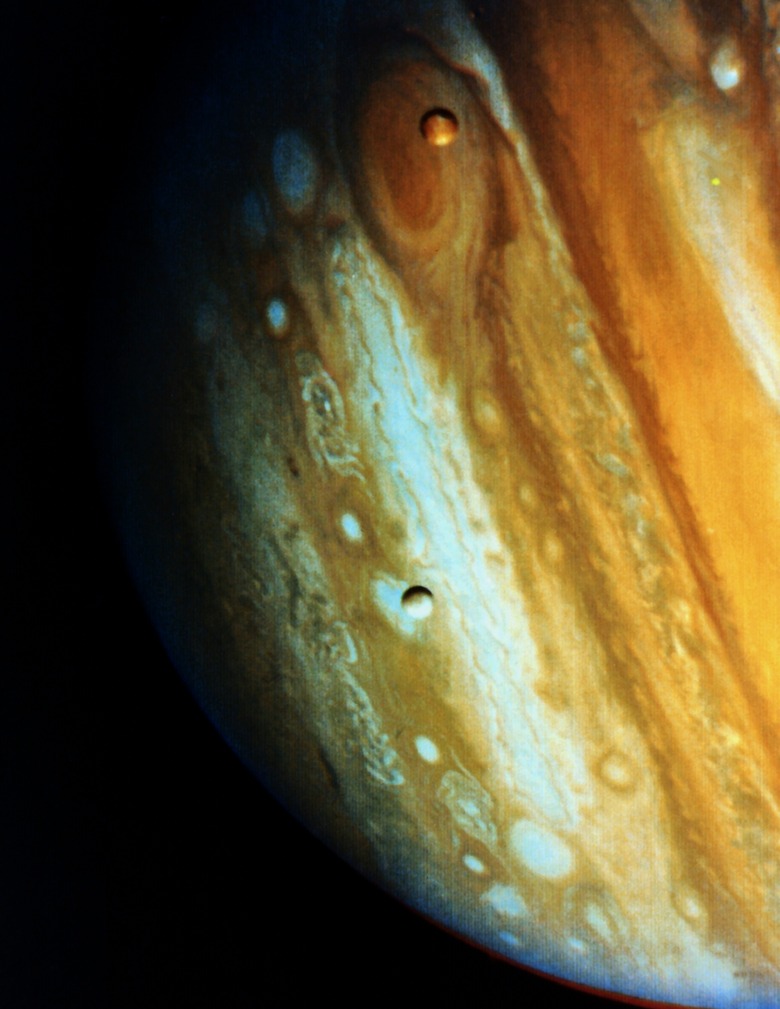Which Planet Has A Storm That Has Been Raging For Centuries?
Most people think of storms as limited phenomena in terms of both time and spatial range; for example, it would be unusual to see a snowstorm blanketing half of the United States and lasting for more than a couple of days. Such is not the case in the solar system, however. Jupiter's Great Red Spot represents a storm system that has been raging for hundreds of years.
The Planet Jupiter
The Planet Jupiter
Jupiter is by far the largest of the eight planets in the solar system. Its nearly 140,000-kilometer diameter makes it about 11 times as wide as Earth. It orbits the sun at a mean distance of 780 million kilometers, placing it about five times as far from the sun as Earth. Unlike Earth, it is a gaseous planet and therefore has no solid surface on which exploratory spacecraft might land. It has an atmosphere consisting mainly of hydrogen and helium, and as of 2014 was believed to have as many as 67 moons. (Ref. 3)
History of the Great Red Spot
History of the Great Red Spot
General consensus among astronomers today holds that Italian scientist Giovanni Cassini was the first person to observe the Great Red Spot in the late 17th century. There is no reason, however, to believe that the storm began only when humans first achieved the ability to see it.
About 100 years ago, the eye-shaped storm was approximately twice its current diameter and it appears to be shrinking still. If it continues to lose size at its current rate, it may become circular by 2040. No one can say how long the Great Red Spot will last, or whether its shrinkage represents the end of the storm's "life" or merely a normal fluctuation. (Ref. 2)
Dimensions of the Storm
Dimensions of the Storm
The Great Red Spot in 2014, while considerably smaller than its greatest observed size, could hold between two-and-a-half and three Earths. Scientists theorize that both its size and extreme persistence relate to Jupiter's high internal heat, and to the fact that since Jupiter lacks land masses, the Great Red Spot always remains, in effect, over a sea, rendering it more stable. The top clouds of the storm lie about eight kilometers higher than the surrounding clouds, and it is prevented from moving north or south by a pair of jet streams. (Refs. 1, 2)
Properties of the Storm
Properties of the Storm
The Great Red Spot is, in essence, a hurricane. It rotates counter-clockwise, making one full rotation approximately once every six earth days. Wind speeds at its outer edges reach as high as 432 kilometers per hour, or about 270 miles per hour — faster than any winds ever recorded on Earth.
Scientists are unsure what gives the Great Red Spot its color; the most popular theory is that a high concentration of the elements phosphorus and sulfur are responsible. The hue varies from a deeper red at the middle to pale salmon toward the outskirts. (Ref. 2)
Cite This Article
MLA
Crystal, Mike. "Which Planet Has A Storm That Has Been Raging For Centuries?" sciencing.com, https://www.sciencing.com/planet-storm-raging-centuries-23691/. 24 April 2017.
APA
Crystal, Mike. (2017, April 24). Which Planet Has A Storm That Has Been Raging For Centuries?. sciencing.com. Retrieved from https://www.sciencing.com/planet-storm-raging-centuries-23691/
Chicago
Crystal, Mike. Which Planet Has A Storm That Has Been Raging For Centuries? last modified March 24, 2022. https://www.sciencing.com/planet-storm-raging-centuries-23691/
